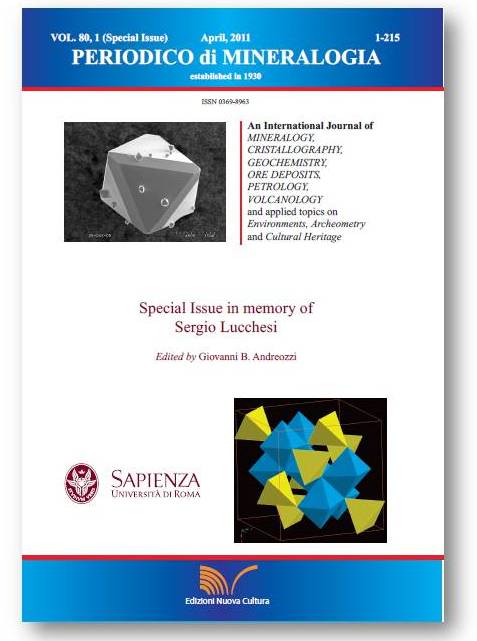Chromite to magnetite transformation: compositional variations and cation distributions (southern Aosta Valley, Western Alps, Italy)
DOI:
https://doi.org/10.2451/2011PM0001Keywords:
chromite, magnetite, mineral chemistry, X-ray structure refinement, cation distributionAbstract
Periodico di Mineralogia (2011), 80, 1 (Special Issue), 1-17 - DOI: 10.2451/2011PM0001
Special Issue in memory of Sergio Lucchesi
Chromite to magnetite transformation: compositional variations and cation distributions (southern Aosta Valley, Western Alps, Italy)
Antonio Della Giusta1, Susanna Carbonin1,* and Umberto Russo2
1Dipartimento di Geoscienze, Università di Padova, Italy
2Dipartimento di Scienze Chimiche, Università di Padova, Italy
*Corresponding author: susanna.carbonin@unipd.it
Abstract
Massive magnetite bodies in the southern Aosta Valley, NW Italy, are most probably the product of transformation from a chromite proto-ore forming in the u ltramafic rocks of an ophiolite suite. Chromium was detected in all the magnetite bodies, except in the Cogne deposit. Chromite-magnetite transformation was examined in spinel samples from the Ussel ore deposit by EMPA, XRD and Mössbauer spectroscopy.
Chemical compositions reveal strong chemical inhomogeneity, mainly for Cr and Fe3+. Spot analyses, from core to rim, in the composite chromite-magnetite grains show significant Al decrease accompanied by Mg and Zn depletion, while the sharp Cr decrease is assisted by Fe3+ increase. Cr shows positive linear correlations with Mg, Mn and Zn, and negative with Fe3+and Fe2+. Cr/(Cr+Al) (~ 0.75) and Mg/(Mg+Fe2+) (~ 0.15) reveal substantial modifications of the original chromite. At the chromite-magnetite boundary (Cr ~ 0.8 a.f.u.) variations in both major and minor elements are sharp, defining a compositional gap between the normal structure of chromite and the inverse structure of magnetite. At this boundary, Ti4+ shows a prominent peak (~ 0.02 a.f.u.) with respect to core and rim, 0.003 and 0.006 a.f.u., respectively. R2+2TiO4 component (R = Fe2+, Mg, Mn2+) is relevant for charge balance requirement and in the transition from chromite to magnetite, due to the inversion of structure.
Single crystal X-ray investigation of seven Cr-magnetites was undertaken to detail intracrystalline cation distributions and to compare them with that of the Cr-free magnetite (Cogne). The non-homogeneity of the chemical composition greatly affects the cell parameters, which do not show any definite trend, in spite of considerable Cr variation. M.a.n. (T) and m.a.n. (M) are almost constant; the only parameter which substantially changes, decreasing Cr, is the oxygen coordinate, from 0.2574 to 0.2553.
The bulk sample from which the seven crystals were selected was also examined by Mössbauer spectroscopy. Its spectrum is typical of magnetite with iron partially replaced by other divalent and trivalent cations, and consists of two partially overlapping sextets.
Cr is replaced by both Fe3+ and Fe2+ in the M site, always with a definite disorder of Fe2+ in T site. This feature was also observed in the Cogne Cr-free magnetite. All samples retain an average formal iron valence near 2.5+ on the M site, suggesting a structure-stabilising role due to charge hopping.
Data suggest that the Cogne magnetite may represent the last stage of the chromite to magnetite transformation, with the sole survival of the inverse spinel structure. Samples from all the other deposits, retaining appreciable amounts of relict Cr-enriched areas, represent a transitional situation, where both normal and inverse structures still coexist. The inhomogeneous chemical composition revealed at the micrometer scale seems to be the consequence of a complex transformation responsible for the survival of microsites the compositions of which recall, but do not fit, those of a chromite proto-ore.
Key words: chromite, magnetite, mineral chemistry, X-ray structure refinement, cation distribution.


